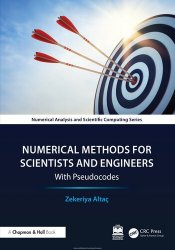 Название: Numerical Methods for Scientists and Engineers: With Pseudocodes
Название: Numerical Methods for Scientists and Engineers: With PseudocodesАвтор: Zekeriya Altaç
Издательство: CRC Press
Серия: Numerical Analysis and Scientific Computing Series
Год: 2025
Страниц: 786
Язык: английский
Формат: pdf (true)
Размер: 26.2 MB
Numerical Methods for Scientists and Engineers: With Pseudocodes is designed as a primary textbook for a one-semester course on Numerical Methods for sophomore or junior-level students. It covers the fundamental numerical methods required for scientists and engineers, as well as some advanced topics which are left to the discretion of instructors.
The objective of the text is to provide readers with a strong theoretical background on numerical methods encountered in science and engineering, and to explain how to apply these methods to practical, real-world problems. Readers will also learn how to convert numerical algorithms into running computer codes.
Features:
- Numerous pedagogic features including exercises, “pros and cons” boxes for each method discussed, and rigorous highlighting of key topics and ideas
- Suitable as a primary text for undergraduate courses in numerical methods, but also as a reference to working engineers
- A Pseudocode approach that makes the book accessible to those with different (or no) coding backgrounds, which does not tie instructors to one particular language over another
- A dedicated website featuring additional code examples, quizzes, exercises, discussions, and more: github.com/zaltac/NumMethodsWPseudoCodes
All numerical algorithms in this text are presented as self-contained pseudomodules that can be converted and used in any program. The modules are written as simply as possible (with very few commands) so that translation to other programming platforms is as easy as possible. This approach blends the algorithms and methods with sufficient mathematical theory and supports easy implementation of the algorithms.
Why pseudocode? Today’s engineers and scientists are expected to become proficient in one or more programming languages (C/C++, Python, Visual Basic, Fortran, etc.), as well as a number of software packages (MatLab, Mathematica, Maple, etc.) known as the Computer or Symbolic Algebra System (CAS or SAS). To be more general and inclusive, the text is not tied to any specific programming language or to any specific CAS software. This approach aims to teach numerical methods that students will encounter in their future courses or careers while enabling them to gain the ability to prepare and/or use well-structured programs in a variety of languages.
The motivation for adopting a pseudocode approach is that the texts providing brief algorithms target an audience with some programming experience. A beginner-level undergraduate student without sufficient hands-on programming skills, in general, struggles to convert such algorithms into running computer programs. The pseudocodes adopted in the text mimic the full features of a real program, including input/output statements, structured coding, and line-by-line explanatory comments and annotations, so that translation to other programming languages is as simple as possible. By incorporating the pseudocode approach adopted here as a teaching tool, a student with minimum programming skills should be able to not only grasp the logic of the numerical method but also gain insight on how to implement it in a programming language of his or her choice.
The text contains a total of 96 pseudocodes. Every numerical algorithm is presented as a completely independent pseudomodule that can be converted and used with other programs. Some pseudocodes use one or more of the pseudomodules presented in prior sections or chapters. This text also puts forth a convention for writing pseudocodes since there is no common standard. However, basic structured programming statements and commands of common programming languages are adopted in this pseudocode convention, which is presented in the Appendix section under the heading “How to Read and Write Pseudocodes.” With this as a reference, a student with an elementary programming background can easily follow, write, and convert the pseudocodes to any programming language s/he desires.
Contents:
Скачать Numerical Methods for Scientists and Engineers With Pseudocodes
